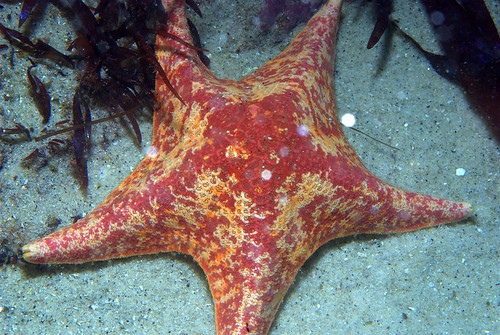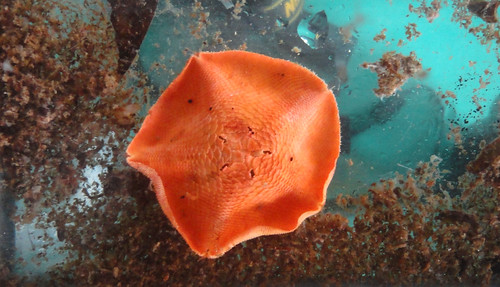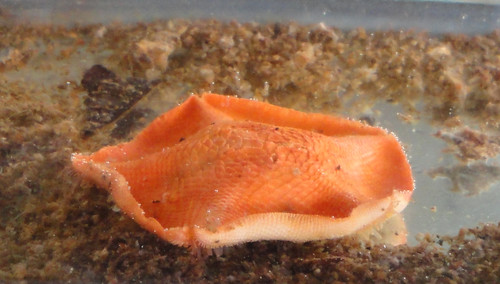 |
| Baker Island |
Back in 2008 I wrote a post about a great looking starfish that I wanted to know more about, a weird looking deep-sea star called Tremaster mirabilis!
Its a striking looking animal and its not unusual for odd looking animals to have some kind of story attached to it..and as we learn more about it, the more intriguing it becomes!

The species name "mirabilis" is Latin for "wonderful" or "to marvel at" and as we'll see the genus name Tremaster has an equally appropriate descriptive etymology!
Since I wrote that introductory post in 2008 not only have I learned more about it-but we've now seen it ALIVE all over the Atlantic and the tropical Pacific thanks to the livestream videos of Okeanos Explorer!
Brief Introductory Details: Tremaster is a starfish in the family Asterinidae, that puts in the same family as "bat stars" and a bunch of other sea stars you probably recognize from shallow waters and home aquariums. Go read this account on this huge and diverse group, which I wrote a while back...
 |
| image via Flickr by Ed Bierman |
Katie published this great paper on feeding biology and ecology of deep-sea asteroids collected off the coast of Canada in the North Atlantic in Deep-Sea Research in 2013. I blogged it up here.
During the course of Katie's research she collected a fair amount of cool "anecdotal data" which amounts to singular observations and some other stuff which furthers the "natural history observation" of a starfish about which we know very little! So her observations along with some further observations from the 2017 research legs of the NOAA Okeanos Explorer, some further homework on my part and voila!
Let us learn MORE about the weird starfish Tremaster mirabilis!
1. It eats coral (possibly)
Probably one of the BIGGEST questions I had for such a strange looking sea star! As we'll see, this species is seen quite a bit and yet one of the most immediate questions about it seemed elusive!
Fortunately Katie Gale was quite lucky and was able to capture and image of this specimen of T. mirabilis taken by the fine people who operate the Remotely Operated Vehicle ROPOS/DFO. Gale's paper cites this image showing our mysterious starfish feeding on CORAL!
Specifically the octocoral Acanthogorgia!
Tremaster mirabilis occurs widely around the world and of course, its always possible that there is variation in feeding or that possibly the animal in the picture has somehow been caught doing something completely else that we have no clue about-BUT our best guess is that its feeding. So, we continue on with that notion..
BUT we have THIS image taken on Whaley Seamount during Leg 3 of the Okeanos Explorer mission at 875m!
Could its location on the rock surface be because its near a yummy food source? Another coral predator to add into our understanding of deep-sea coral ecosystems???
2. Time lapse movement and??
This probably seems like a common sense thing-we KNOW starfish move albeit VERY slowly. and can actually show some behavioral complexity (here)
Katie nabbed some of this GREAT video showing this species moving around its aquarium and more importantly NOT attacking this sea anemone in the aquarium.
This is actually an important point because we know MOST starfish CAN move but they often don't.
So, ACTUALLY capturing it doing so gives us some insight into what they do when we aren't watching them..
Katie for example caught THIS unusual variation in posture: Could this be avoidance of the bottom somehow? Filter feeding? Some kind of stress response?
Note in this image that the "skirt" is lifted compared to the in situ Okeanos images below where the animal is flush with the bottom..


What is it doing?? This is a bit of a A mystery.
and on Pau Pau Seamount and elsewhere Tremaster is CRAAZY abundant! Are they moving around to feed? to reproduce? How does all of this come together??? These behavioral bits add to our understanding but also to the mystery!
If we sped the movement of this "constellation" of Tremaster mirabilis up, would we still see no movement? or is it a Times Square of Deep-Sea Starfishes???
If we sped the movement of this "constellation" of Tremaster mirabilis up, would we still see no movement? or is it a Times Square of Deep-Sea Starfishes???
It USED to be that everything we knew about this species was taken from museum specimens and indeed we are STILL dependent on samples from throughout the world for new records of where many species live.
There is some question about whether or not this one species "Tremaster mirabilis" is actually one species or possibly several 'cryptic' species disguised by the fact that all the individuals observed all appear to be the same.
The external characters vary only slightly and its not unusual for a widely occurring species to demonstrate some... variation throughout its range. However, when we examine dead museum specimens we are often missing data such as color and behavior which can be important. Especially when its range where it lives is at least THREE oceans!
Tremaster is a moderately occurring deep-sea species.. occurring roughly between 200 and 600 m
Thanks to submersibles such as Okeanos Explorer we now have VIDEO and ON SITE (in situ) observations of LIVING animals!
Tremaster mirabilis is supposed to be one species..but as you can see there is a SLIGHT difference in body form..
North & Central Atlantic: An image from Nygren Canyon (top) and the lower image from Puerto Rico. Note there's more of a "skirt" around the edge versus the Pacific ones.
Throughout the tropical Pacific
Here's a brilliant deep-orange one seen on the recent Okeanos leg from Jarvis Island..
And interesting brick colored one from Pau Pau seamount
and this interesting lighter colored individual from Baker Island..
 |
Another place where Tremaster shows up? Antarctica and nearby...
Also had a nice Tremaster mirabilis (the ‘orange peel star’, we joke on #AugSurvey) pic.twitter.com/Mw38CCmtjY— Claude Nozeres (@cnozeres) September 16, 2016
4. There are Jurassic Fossils
As if dealing with living animals weren't enough, these intriguing beasts show a CLEAR relationship to at least TWO Jurassic fossils!
Bear in mind that the Jurassic is quite a LONG time ago. These sea star were living in the world's oceans while dinosaurs roamed the Earth!
AND like its modern descendents-these were quite spread out. Antarctica versus Switzerland!
Here's Protremaster felli, from the Jurassic of Antarctica! Described by Andrew Smith and T. H. Tranter in Geology Magazine 1985
and YET another "Tremaster" like fossil sea star, described in 1981 from the Jurassic of Switzerland: Mesotremaster zbindeni described by famed Swiss paleontologist Hans Hess!
 |
| Image from the Wikipedia file: https://commons.wikimedia.org/wiki/File:Mesotremaster_felli.jpg |
Close up of the plate detail showing a familiar pattern for "Tremaster" like asteroids...

4a. Interesting Evolutionary History... I had also mentioned briefly in my account of the importance of the family Asterinidae (here) And well, Tremaster is possibly VERY important to the evolution of starfishes. It has a history showing them in the Jurassic.. and to those in the know.. these show a close resemblance to several weird deep-sea species!
5. What does "Tremaster" actually mean? And"brood chambers"??
FINALLY! What does the genus "Tremaster" actually MEAN anyway? "aster" is obviously "star" but it turns out "Trema-" refers to "aperture" or OPENING!
When Addison Emery Verrill described this genus in 1880 he made allusion to these FIVE openings present in each interradius! These were one of the distinctive characters he used to diagnose his (then) new genus!! and "mirabilis" of course refers to "wonderful"
Here's a photo of the underside of a Tremaster specimen.. the openings are indicated by yellow circles!
So, as it turns out if you look more CLOSELY at these openings, they are actually OPENINGS into chambers present INSIDE and THROUGH the body wall and open up on the TOP:
Here are images of a dissected individual from the underside showing these openings (i.e. these are close ups of what's in the yellow circles above)
According to the author who described this species (and subsequent literature), there are actually BROODED young in these chambers! Its not clear to me if they are simply embryos or actual juvenile individuals. Strangely enough, these have not been documented..at least not in the literature that I could locate. and I have yet to actually spot them. But perhaps I've simply not been looking at the right ones...
Thus, the openings appear to provide an opening for water to circulate into these chambers which could serve any number of purposes.. Possibly to aerate the "brood" chambers? Or perhaps they assist in the degree of arching the dome-like shape is capable of?? Filter feeding? Predation??
One of the great things about science is how it marches on! Its been 9 years (!!) since I wrote that first post and I LOVE that what in addition to what I've learned from reading, there has ALSO been genuine progress in learning NEW information on the biology of these animals.. And one of these days we will more FULLY understand it and its strange signficance!
Also GREAT to see that animals like this INSPIRE! Here is a GREAT illustration of this species by "Cartoon Neuron" on Twitter...
@echinoblog My fav Tremaster thanks you! Have a great weekend ^_^ pic.twitter.com/olxTQolezd— Cartoon Neuron (@Cartoon_Neuron) May 12, 2017















No comments:
Post a Comment